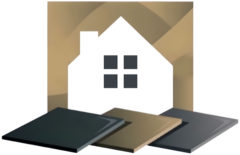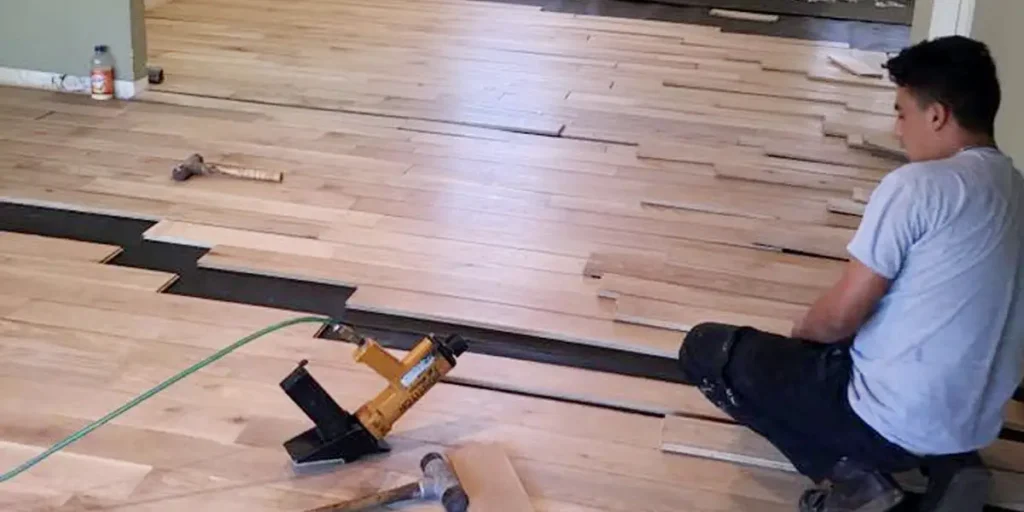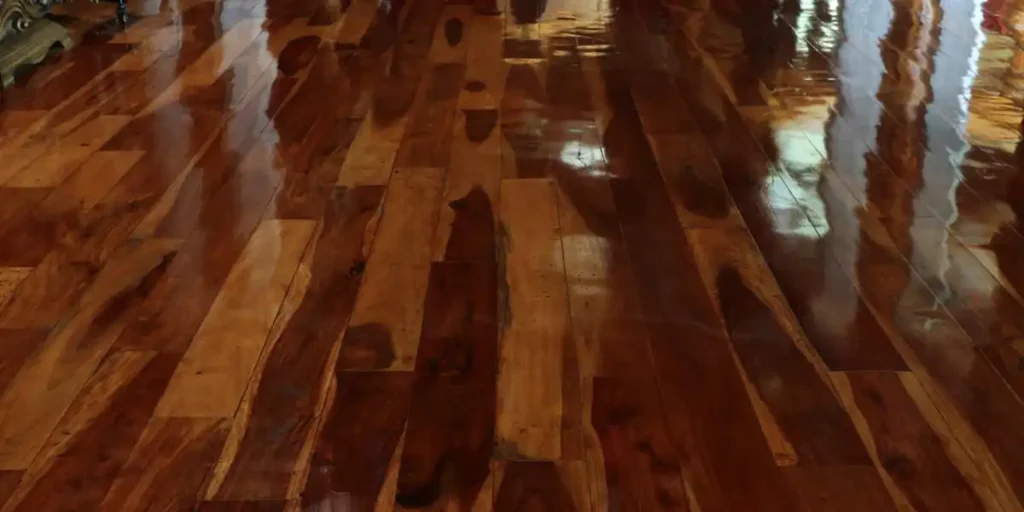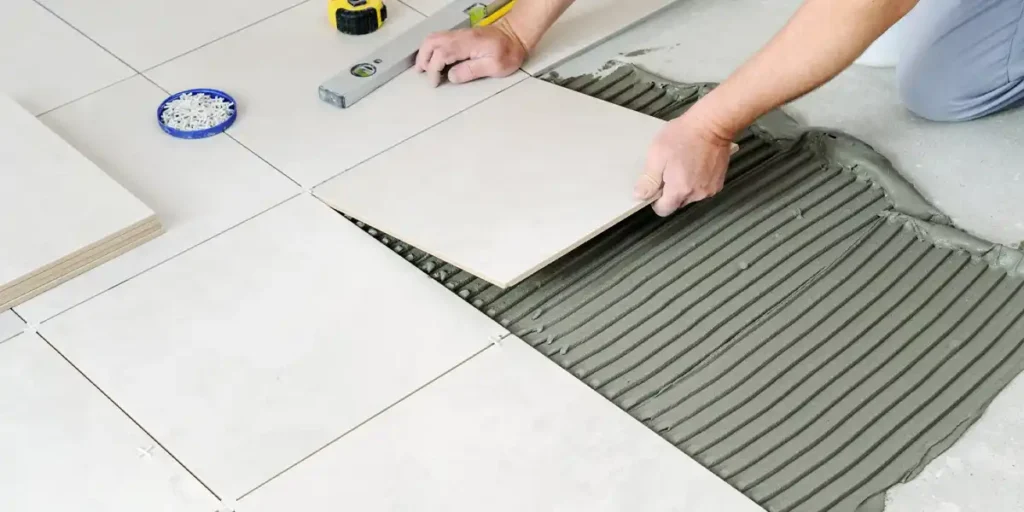Swollen laminate flooring can feel like a frustrating defeat for homeowners. Once admired for its sleek appearance and durability, it now shows signs of swelling, warping, and unevenness.
But does swollen laminate always mean expensive replacements? Not necessarily.
This guide provides practical solutions to repair swollen laminate flooring without replacing it, offering a cost-effective path to restoring its former beauty.
Understanding the Enemy: Why Does Laminate Flooring Swell?
To address swollen laminate flooring effectively, it’s crucial to understand why it happens. Laminate flooring is constructed from layers, including a core of compressed fiberboard, which is highly sensitive to moisture.
Here are the common culprits:
- Leaks: Persistent water from leaking pipes, roofs, or appliances can seep into the laminate.
- Spills: Unattended spills allow moisture to penetrate seams and edges.
- High Humidity: Prolonged exposure to humid conditions causes gradual swelling.
- Improper Installation: Gaps or inadequate sealing during installation can invite water damage.
- Subfloor Issues: A damp or uneven subfloor can create long-term challenges.
By identifying the cause, you’ll better understand how to repair swollen laminate flooring without replacing it and prevent future damage.
Assessing the Damage: Is Repair Possible?
Before jumping to solutions, thoroughly inspect the extent of the swelling. Your approach will depend on the severity of the issue.
Steps to Assess the Damage
- Check Swelling Levels: Is it minor bubbling or severe warping?
- Inspect Mold Growth: Mold or mildew might indicate deeper issues requiring professional attention.
- Determine Spread: Examine if the damage is confined to a few planks or affects a larger area.
Damage localized to a few planks is often repairable without a full replacement, saving you both money and effort.
Solutions for Repairing Swollen Laminate Flooring Without Replacing It
1. Drying the Affected Area
For minor swelling, drying can work wonders.
- How to Dry: Use fans, dehumidifiers, or natural ventilation to dry the swollen area.
- Patience Required: Avoid rushing the process, as premature use may worsen the swelling.
This simple yet effective method is ideal for minor moisture exposure.
2. Replacing Individual Planks
If drying isn’t enough, replacing damaged planks might be the best option.
Step-by-Step Process:
- Remove the swollen planks using a pry bar or utility knife.
- Measure and purchase replacement planks matching your floor’s color and style.
- Install the new planks, ensuring a snug fit.
Pro Tip: Keep extra planks from the original installation to avoid mismatched replacements.
3. Using Repair Kits for Cosmetic Damage
For slight bubbling or surface imperfections, a laminate repair kit may suffice.
- What’s Included: Repair kits often contain putty, wax fillers, and color-matching pens.
- Application: Use the filler to level small areas and restore the appearance of the damaged section.
This method is perfect for addressing superficial damage.
Preventing Future Water Damage: Proactive Measures for Lasting Floors
Taking preventative measures is the best way to avoid the frustration and costs associated with repairing water-damaged laminate flooring. By addressing potential vulnerabilities and maintaining good practices, you can significantly extend the lifespan of your laminate floors.
1. Seal Gaps and Edges
Proper sealing during installation is one of the most effective ways to prevent water damage. Apply high-quality sealants to the edges and seams of your laminate flooring to create a water-resistant barrier. This step is particularly crucial in moisture-prone areas like kitchens, bathrooms, and basements. Don’t forget to inspect the seals periodically; even the best sealants can wear down over time and require reapplication.
2. Use Protective Mats
Strategically placing mats in high-risk areas such as entryways, kitchens, and bathrooms can act as the first line of defense against moisture. Door mats trap water brought in from outside, while rugs in kitchens and bathrooms absorb splashes and spills. Choose non-slip, water-resistant mats to ensure both safety and effectiveness.
3. Clean Spills Immediately
Water left to sit on laminate flooring can seep through the seams and edges, leading to swelling and warping. Make it a habit to wipe up spills immediately with a dry or slightly damp cloth. For larger spills, use absorbent towels and follow up with fans or a dehumidifier to ensure the area is completely dry.
4. Maintain Humidity Levels
Laminate flooring is sensitive to humidity fluctuations, which can cause swelling and buckling. Invest in a reliable dehumidifier, especially if you live in a damp or humid climate. Aim to keep indoor humidity levels between 30% and 50% to minimize the risk of damage. Regularly monitor your home’s humidity levels with a hygrometer for precise control.
These preventative measures not only safeguard your laminate flooring but also ensure it retains its beauty and durability for years to come. A proactive approach today can save you significant time, effort, and expense in the future.
Conclusion
Learning how to repair swollen laminate flooring without replacing it saves both time and money. From drying techniques to individual plank replacement, you have several effective options for tackling damage.
Once repaired, focus on prevention to keep your floors looking their best for years to come. A little maintenance goes a long way in protecting your investment.
Need help with laminate flooring repair? Cardenas Flooring is just a call away. Contact us for reliable service today!
FAQs
Can I use heat tools like a hairdryer to fix swollen laminate flooring?
Using heat tools such as a hairdryer is not recommended for swollen laminate flooring. Excessive heat can warp or crack the laminate, worsening the problem. Instead, rely on natural drying methods, fans, or dehumidifiers to remove moisture gradually and safely. For severe swelling, consider localized plank replacement or professional repair services to ensure effective results without further damage.
How do I match replacement planks to my existing laminate floor?
To match replacement planks, check with the original supplier or retailer for the same brand and style. Keep extra planks from the initial installation, if possible. If unavailable, take a sample of the damaged plank to a flooring store for assistance in finding a close match. Color-matching pens or fillers can also help minimize slight variations between new and existing planks.
What if swollen laminate flooring is widespread? Can I still repair it?
Widespread swelling is challenging to repair without replacement. While drying might work for minor issues, extensive damage often requires removing and replacing affected planks. If swelling has spread across the floor or caused subfloor damage, consult a professional to evaluate the extent of repairs needed. Preventative maintenance is crucial to avoid such issues in the future.
How can I tell if water damage has reached the subfloor beneath my laminate?
Signs that water damage has reached the subfloor include persistent dampness, mold growth, or a musty odor. You may also notice uneven flooring or soft spots when walking. In such cases, removing the laminate and inspecting the subfloor is essential. If the subfloor is compromised, it will need professional repair or replacement to maintain structural integrity.
Is it worth repairing swollen laminate flooring, or should I replace it entirely?
Repairing swollen laminate flooring is cost-effective for minor or localized damage. However, if the swelling is extensive, widespread, or involves mold and subfloor damage, replacement may be the better long-term solution. Assess the damage carefully, and if unsure, consult a flooring specialist to weigh the repair costs against full replacement expenses.




